The nervous system, illustrated Figure 11.2.211.2.2, is the human organ system that coordinates all of the body’s voluntary and involuntary actions by transmitting electrical signals to and from different parts of the body. Specifically, the nervous system extracts information from the internal and external environments using sensory receptors. It then usually sends signals encoding this information to the brain, which processes the information to determine an appropriate response. Finally, the brain sends signals to muscles, organs, or glands to bring about the response. In the example above, your eyes detected the boy, the information traveled to your brain, and your brain instructed your body to act so as to avoid a collision.
Signals of the Nervous System
The signals sent by the nervous system are electrical signals called nerve impulses, and they are transmitted by special nervous system cells named neurons, or nerve cells, like the one in Figure 11.2.311.2.3 (all the parts of a neuron are explained in the next section). Dendrites of a neuron receive nerve impulse from other cells. Long projection (called axons) from neurons carry nerve impulses directly to specific target cells. Schwann cells wrapped around the axon are called glial cells. They create myelin sheath which allows the nerve impulse to travel very rapidly through the axons. A cell that receives nerve impulses from a neuron may be excited to perform a function, inhibited from carrying out an action, or otherwise controlled. In this way, the information transmitted by the nervous system is specific to particular cells and is transmitted very rapidly.
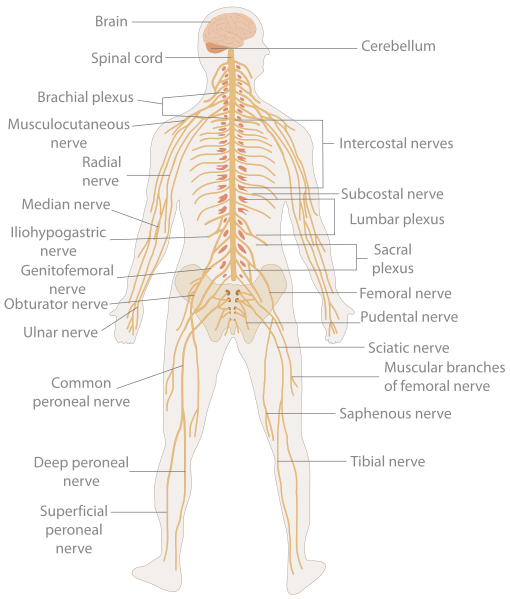
In fact, the fastest nerve impulses travel at speeds greater than 100 meters per second! Compare this to the chemical messages carried by the hormones that are secreted into the blood by endocrine glands. These hormonal messages are “broadcast” to all the cells of the body, and they can travel only as quickly as the blood flows through the cardiovascular system.
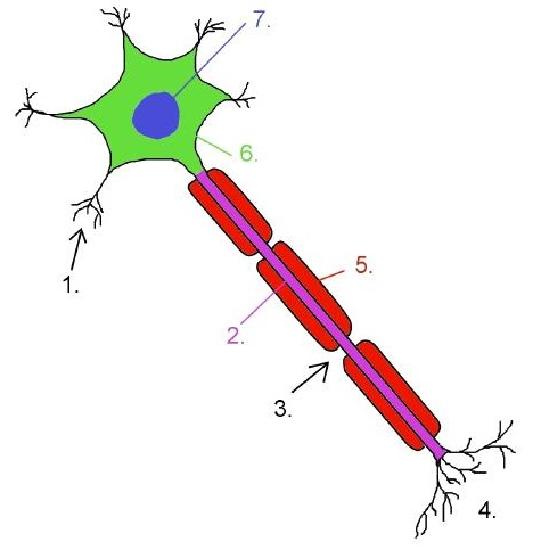
Organization of the Nervous System
As you might predict, the human nervous system is very complex. It has multiple divisions, beginning with its two main parts, the central nervous system (CNS) and the peripheral nervous system (PNS), as shown in Figure 11.2.411.2.4. The CNS includes the brain and spinal cord, and the PNS consists mainly of nerves, which are bundles of axons from neurons. The nerves of the PNS connect the CNS to the rest of the body. You can learn much more about the CNS by reading the concept Central Nervous System.
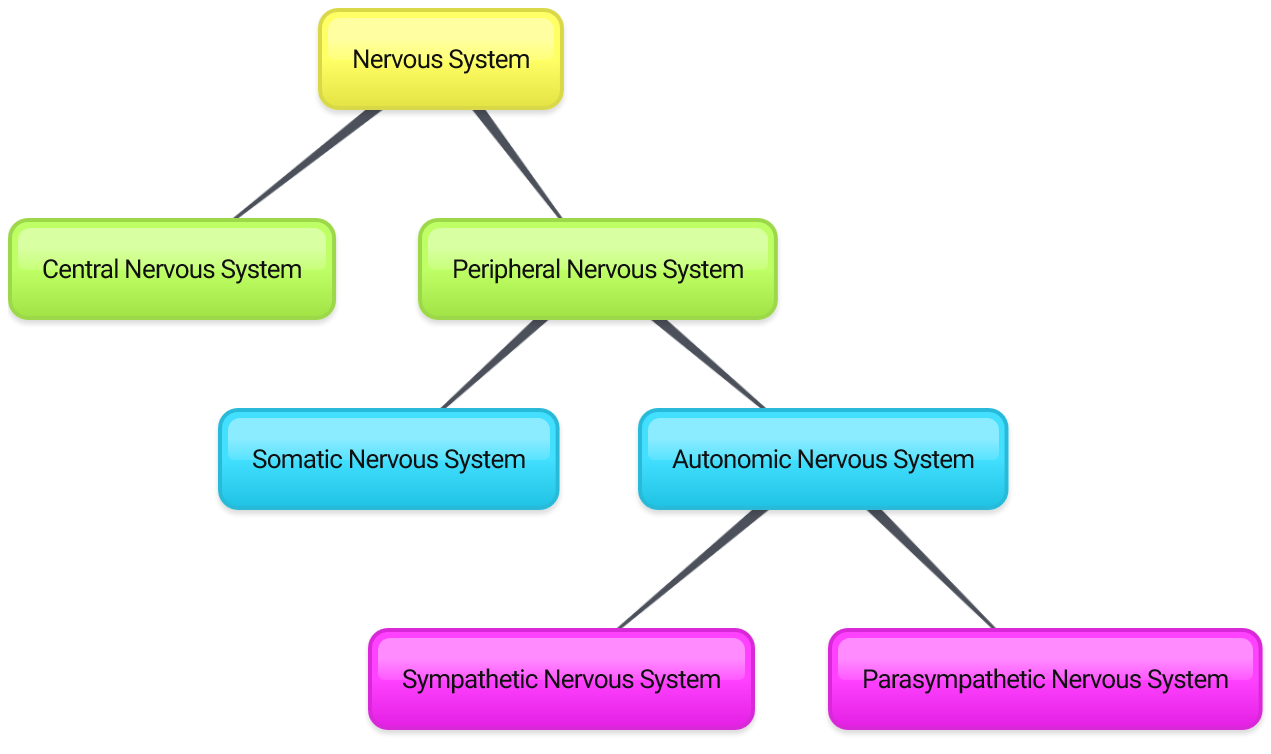
The PNS is divided into two major parts, called the autonomic and somatic nervous systems. The somatic nervous system controls activities that are under voluntary control, such as turning a steering wheel. The autonomic nervous system controls activities that are not under voluntary control, such as digesting a meal. The autonomic nervous system has three divisions: the sympathetic division, which controls the fight-or-flight response during emergencies; the parasympathetic division, which controls the routine “housekeeping” functions of the body at other times; and the enteric division, which provides local control of the digestive system. You can learn more about the PNS and its subdivisions by reading the concept Peripheral Nervous System.
Central Nervous System
Homunculus
Figure 11.5.111.5.1 is a very odd-looking drawing and is called a homunculus. The mass represents a cross-sectional wedge of the human brain. The drawing shows some areas of the brain associated with different parts of the body. As you can see, larger areas of the brain in this region are associated with the hands, face, and tongue than the legs and feet. Given the importance of speech, manual dexterity, and face-to-face social interactions in human beings, it is not surprising that relatively large areas of the brain are needed to control these body parts. The brain is the most complex organ in the human body and part of the central nervous system.
Figure 11.5.111.5.1: Brain-Body Map. There’s a map of your body on your brain’s cortex, but the map is not proportional to actual space. Sensitive parts like the face and fingers are represented by more areas than less sensitive parts like the legs or back. (CC BY 3.0; OpenStax via Wikimedia.org).
What Is the Central Nervous System?
The central nervous system (CNS) is the part of the nervous system that includes the brain and spinal cord. Figure 11.5.211.5.2 shows the central nervous system as one of the two main divisions of the total nervous system. The other main division is the peripheral nervous system (PNS). The CNS and PNS work together to control virtually all body functions. You can read much more about the PNS in the concept Peripheral Nervous System.
The delicate nervous tissues of the central nervous system are protected by major physical and chemical barriers. Physically, the brain and spinal cord are surrounded by tough meninges, a three-layer protective sheath that also contains cushioning cerebrospinal fluid. The bones of the skull and spinal vertebrae also contribute to physically protecting the brain and spinal cord. Chemically, the brain and spinal cord are isolated from the circulation — and most toxins or pathogens in the blood — by the blood-brain barrier. The blood-brain barrier is a highly selective membrane formed of endothelial cells (a type of glial cells) that separates the circulating blood from the extracellular fluid in the CNS. The barrier allows water, certain gases, glucose, and some other molecules needed by the brain and spinal cord to cross from the blood into the CNS while keeping out potentially harmful substances. These physical and chemical barriers make the CNS less susceptible to injury. However, damage to the CNS is likely to have more serious consequences.
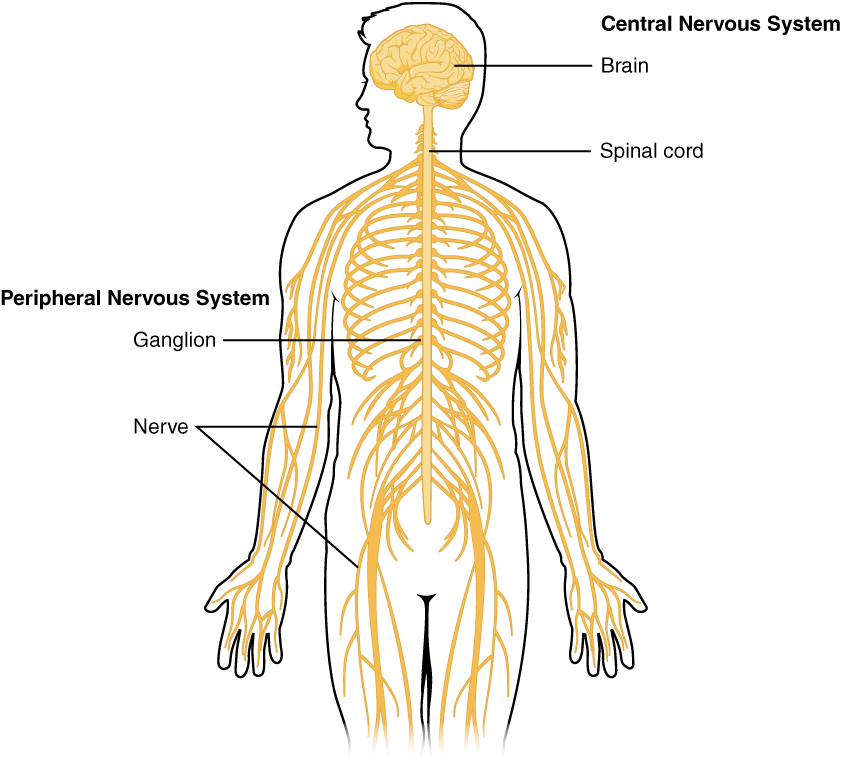
The Brain
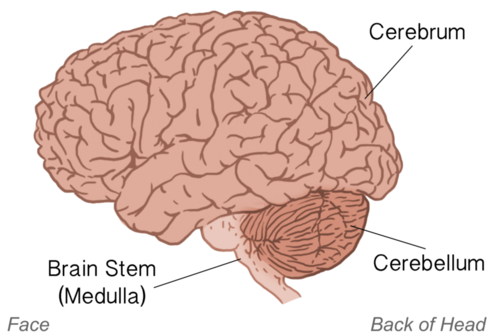
The brain is the control center not only of the rest of the nervous system but of the entire organism. The adult brain makes up only about 2 percent of the body’s weight, but it uses about 20 percent of the body’s total energy. The brain contains an estimated one hundred billion neurons, and each neuron has thousands of synaptic connections to other neurons. The brain also has about the same number of glial cells as neurons. No wonder the brain uses so much energy! In addition, the brain uses mostly glucose for energy. As a result, if the brain is deprived of glucose, it can lead to unconsciousness. The brain is able to store some glucose in the form of glycogen, but in much smaller amounts than are found in the liver and skeletal muscles.
The brain controls such mental processes as reasoning, imagination, memory, and language. It also interprets information from the senses and commands the body how to respond. It controls basic physical processes such as breathing and heartbeat as well as voluntary activities such as walking and writing. The brain has three major parts: the cerebrum, cerebellum, and brain stem (Figure 11.5.311.5.3).
Figure 11.5.311.5.3 shows the brain from the left side of the head. It shows how the brain would appear if the skull and meninges were removed. The brain stem (or medulla) links to the spinal cord. The cerebellum is a small section at the back of the brain. The largest part of the brain is the cerebrum.
Cerebrum
The cerebrum is the largest part of the brain. It controls conscious, intellectual functions. For example, it controls reasoning, language, memory, sight, touch, and hearing. When you read a book, play a video game, or recognize a classmate, you are using your cerebrum.
Hemispheres and Lateralization of the Cerebrum
The cerebrum is divided from front to back into two halves called the left and right hemispheres. The two hemispheres are connected by a thick bundle of axons, known as the corpus callosum, which lies deep within the brain. The corpus callosum is the main avenue of communication between the two hemispheres. It connects each point in the cerebrum to the mirror-image point in the opposite hemisphere.
The right and left hemispheres of the cerebrum are similar in shape, and most areas of the cerebrum are found in both hemispheres. Some areas, however, show lateralization, or a concentration in one hemisphere or the other. For example, in most people, language functions are more concentrated in the left hemisphere, whereas abstract reasoning and visual-spatial abilities are more concentrated in the right hemisphere.
For reasons that are not yet clear, each hemisphere of the brain interacts primarily with the opposite side of the body. The left side of the brain receives messages from and sends commands to the right side of the body, and the right side of the brain receives messages from and sends commands to the left side of the body. Sensory nerves from the spinal cord to the brain and motor nerves from the brain to the spinal cord both cross the midline of the body at the level of the brain stem.
Cerebral Cortex
Most of the information processing in the brain actually takes place in the cerebral cortex. This is a rind of gray matter and other tissues just a few millimeters thick that makes up the outer surface of the cerebrum in both hemispheres of the brain. The cerebral cortex has many folds in it that greatly increase the amount of surface area of the brain that can fit within the skull. Because of all the folds in the human cerebral cortex, it has a surface area of about 2,500 cm2(2.5 ft2). The size and importance of the cerebral cortex are far greater in the human brain than the brains of any other vertebrates including nonhuman primates.
Lobes of the Cerebral Cortex
Each hemisphere of the cerebrum is further divided into the four lobes shown in Figure 11.5.411.5.4 and described below.
1. The frontal lobes are located at the front of the brain behind the forehead. The frontal lobes are associated with executive functions such as attention, self-control, planning, problem-solving, reasoning, abstract thought, language, and personality.
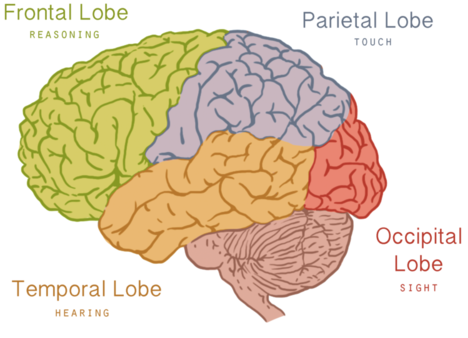
2. The parietal lobes are located behind the frontal lobes at the top of the head. The parietal lobes are involved in sensation, including temperature, touch, and taste. Reading and arithmetic are also functions of the parietal lobes.
3. The temporal lobes are located at the sides of the head below the frontal and parietal lobes. The temporal lobes enable hearing, the formation and retrieval of memories, and the integration of memories and sensations.
4. The occipital lobes are located at the back of the head below the parietal lobes. The occipital lobes are the smallest of the four pairs of lobes. They are dedicated almost solely to vision.
Inner Structures of the Brain
Several structures are located deep within the brain and are important for communication between the brain and spinal cord or the rest of the body. These structures include the hypothalamus and thalamus. Figure 11.5.511.5.5 shows where these structures are located in the brain. Like the two halves of the cerebrum, the hypothalamus and thalamus exist in two halves, one in each hemisphere.
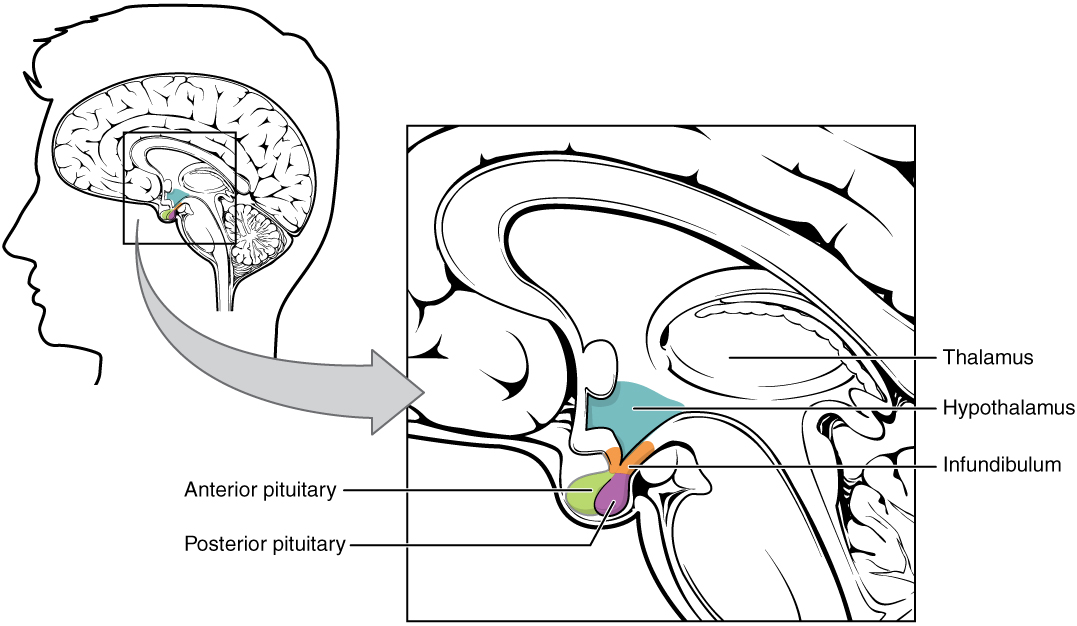
Hypothalamus
The hypothalamus is located just above the brain stem and is about the size of an almond. The hypothalamus is responsible for certain metabolic processes and other activities of the autonomic nervous system, including body temperature, heart rate, hunger, thirst, fatigue, sleep, wakefulness, and circadian (24-hour) rhythms. The hypothalamus is also an important emotional center of the brain. The hypothalamus can regulate so many body functions because it responds to many different internal and external signals, including messages from the brain, light, steroid hormones, stress, and invading pathogens, among others.
One way the hypothalamus influences body functions is by synthesizing hormones that directly influence body processes. For example, it synthesizes the hormone oxytocin, which stimulates uterine contractions during childbirth and the letdown of milk during lactation. It also synthesizes the hormone vasopressin (also called antidiuretic hormone), which stimulates the kidneys to reabsorb more water and excrete more concentrated urine. These two hormones are sent from the hypothalamus via a stalk-like structure called the infundibulum (see diagram above) directly to the posterior (back) portion of the pituitary gland, which secretes them into the blood.
The main way the hypothalamus influences body functions is by controlling the pituitary gland, known as the master gland of the endocrine system. The hypothalamus synthesizes neurohormones called releasing factors that travel through the infundibulum directly to the anterior (front) part of the pituitary gland. The releasing factors generally either stimulate or inhibit the secretion of anterior pituitary hormones, most of which control other glands of the endocrine system.
Thalamus
The thalamus, which is located near the hypothalamus (Figure 11.5.511.5.5), is a major hub for information traveling back and forth between the spinal cord and cerebrum. It filters sensory information traveling to the cerebrum. It relays sensory signals to the cerebral cortex and motor signals to the spinal cord. It is also involved in the regulation of consciousness, sleep, and alertness.
Cerebellum
The cerebellum is just below the cerebrum and at the back of the brain behind the brain stem (see figure 11.5.3). It coordinates body movements and is involved in movements that are learned with repeated practice. For example, when you hit a softball with a bat or touch type on a keyboard you are using the cerebellum. Many nerve pathways link the cerebellum with motor neurons throughout the body.
Brain Stem
Sometimes called the “lower brain,” the brain stem is the lower part of the brain that is joined to the spinal cord. There are three parts to the brainstem: the midbrain, the pons, and the medulla oblongata, which are shown in Figure 11.5.611.5.6 below. The brain stem is primarily involved in the unconscious autonomic functions as well as several types of sensory information. It also helps coordinate large body movements such as walking and running. The midbrain deals with sight and sound information and translates these inputs before sending them to the forebrain. The pons relays messages to other parts of the brain (primarily the cerebrum and cerebellum) and helps regulate breathing. Some researchers have hypothesized that the pons plays a role in dreaming. Some of the functions of the Pons are shared by the medulla oblongata, also called the medulla. The medulla controls several subconscious homeostatic functions such as breathing, heart and blood vessel activity, swallowing, and digestion.
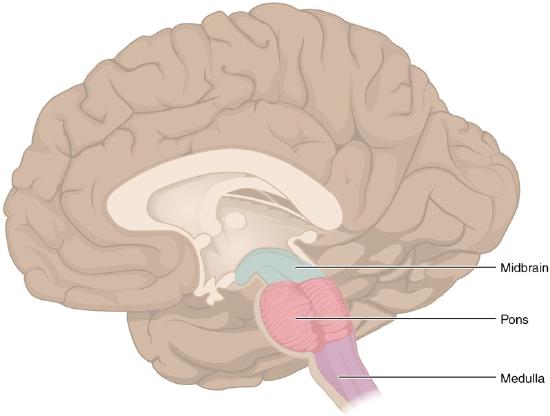
One of the brain stem’s most important roles is that of an “information highway.” That is, all of the information coming from the body to the brain and the information from the cerebrum to the body go through the brain stem. Sensory pathways for such things as pain, temperature, touch, and pressure sensation go upward to the cerebrum, and motor pathways for movement and other body processes go downward to the spinal cord. Most of the axons in the motor pathways cross from one side of the CNS to the other as they pass through the medulla oblongata. As a result, the right side of the brain controls much of the movement on the left side of the body, and the left side of the brain controls much of the movement on the right side of the body.
Spinal Cord
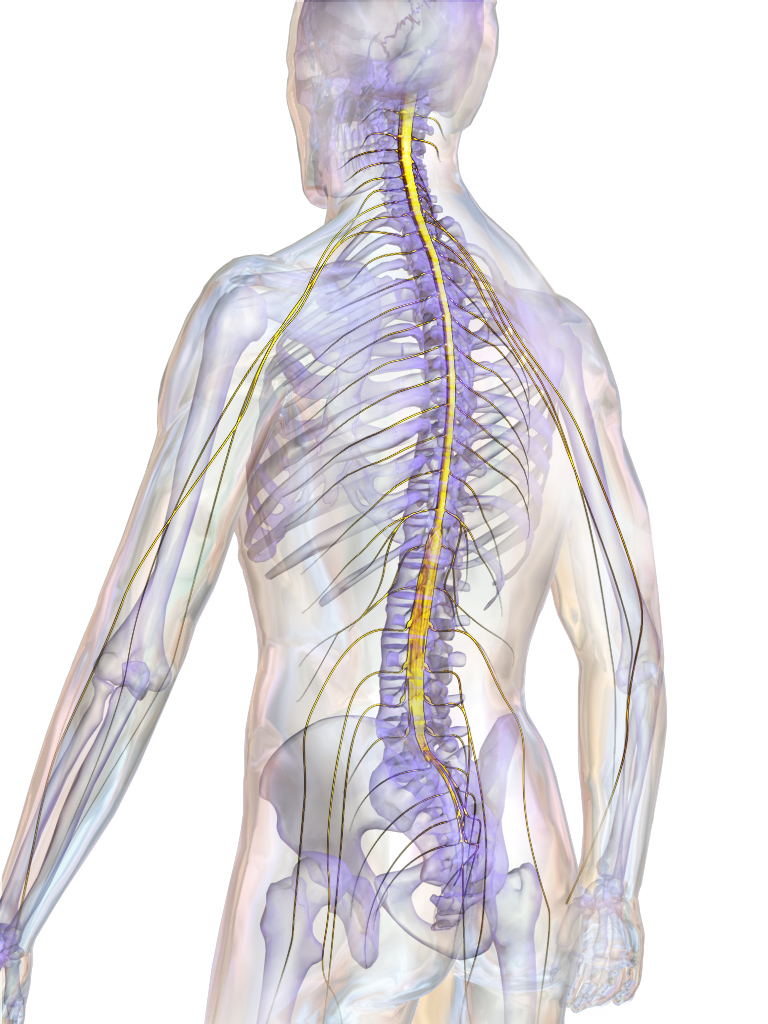
The spinal cord is a long, thin, tubular bundle of nervous tissues that extends from the brain stem and continues down the center of the back to the pelvis. It is highlighted in yellow in Figure 11.5.711.5.7. The spinal cord is enclosed within but is shorter than, the vertebral column.
Structure of the Spinal Cord
The center of the spinal cord consists of gray matter, which is made up mainly of cell bodies of neurons, including interneurons and motor neurons. The gray matter is surrounded by white matter that consists mainly of myelinated axons of motor and sensory neurons. Spinal nerves, which connect the spinal cord to the PNS, exit from the spinal cord between vertebrae (Figure 11.5.811.5.8).
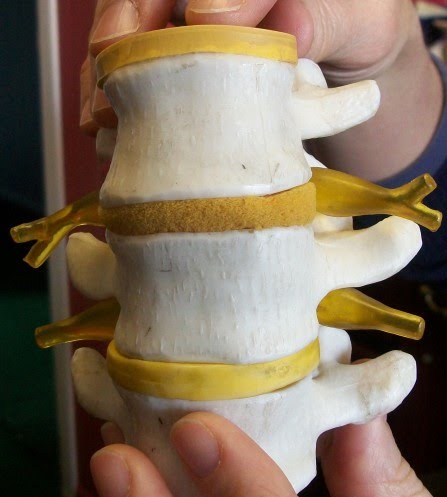
Functions of the Spinal Cord
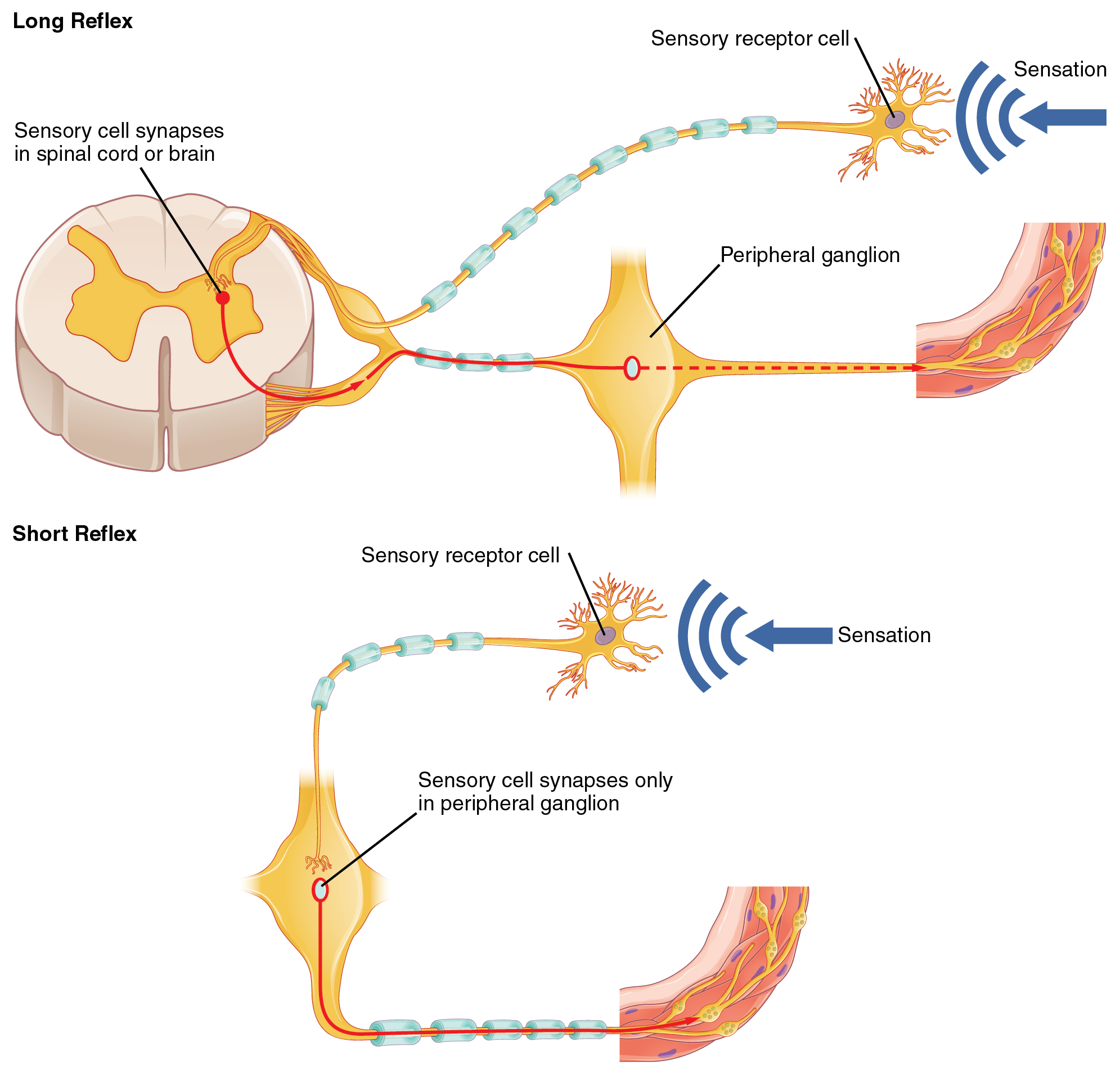
The spinal cord serves as an information superhighway. It passes messages from the body to the brain and from the brain to the body. Sensory (afferent) nerves carry nerve impulses to the brain from sensory receptor cells everywhere in and on the body. Motor (efferent) nerves carry nerve impulses away from the brain to glands, organs, or muscles throughout the body.
The spinal cord also independently controls certain rapid responses called reflexes without any input from the brain. You can see how this may happen in Figure 11.5.911.5.9. A sensory receptor responds to a sensation and sends a nerve impulse along a sensory nerve to the spinal cord. In the spinal cord, the message passes to an interneuron and from the interneuron to a motor nerve, which carries the impulse to a muscle. The muscle contracts in response. These neuron connections form a reflex arc, which requires no input from the brain. No doubt you have experienced such reflex actions yourself. For example, you may have reached out to touch a pot on the stove, not realizing that it was very hot. Virtually at the same moment that you feel the burning heat, you jerk your arm back and remove your hand from the pot.
Injuries to the Spinal Cord
Physical damage to the spinal cord may result in paralysis, which is a loss of sensation and movement in part of the body. Paralysis generally affects all the areas of the body below the level of the injury because nerve impulses are interrupted and can no longer travel back and forth between the brain and body beyond that point. If an injury to the spinal cord produces nothing more than swelling, the symptoms may be transient. However, if nerve fibers (axons) in the spinal cord are badly damaged, the loss of function may be permanent. Experimental studies have shown that spinal nerve fibers attempt to regrow, but tissue destruction usually produces scar tissue that cannot be penetrated by the regrowing nerves, as well as other factors that inhibit nerve fiber regrowth in the central nervous system.
Feature: My Human Body
Each year, many millions of people have a stroke, and stroke is the second leading cause of death in adults. Stroke, also known as cerebrovascular accident, occurs when poor blood flow to the brain results in the death of brain cells. There are two main types of strokes:
- Ischemic strokes occur due to lack of blood flow because of a blood clot in an artery going to the brain.
- Hemorrhagic strokes occur due to bleeding from a broken blood vessel in the brain.
Either type of stroke may result in paralysis, loss of the ability to speak or comprehend speech, loss of bladder control, personality changes, and many other potential effects, depending on the part of the brain that is injured. The effects of a stroke may be mild and transient or more severe and permanent. A stroke may even be fatal. It generally depends on the type of stroke and how extensive it is.
Are you at risk of stroke? The main risk factor for stroke is age: about two-thirds of strokes occur in people over the age of 65. There is nothing you can do about your age, but most other stroke risk factors can be reduced with lifestyle changes or medications. The risk factors include high blood pressure, tobacco smoking, obesity, high blood cholesterol, diabetes mellitus, and atrial fibrillation.
Chances are good that you or someone you know is at risk of a stroke, so it is important to recognize a stroke if one occurs. Stoke is a medical emergency, and the more quickly treatment is given, the better the outcome is likely to be. In the case of ischemic strokes, the use of clot-busting drugs may prevent permanent brain damage if administered within 3 or 4 hours of the stroke. Remembering the signs of a stroke is easy.
They are summed up by the acronym FAST, as explained in the chart below.
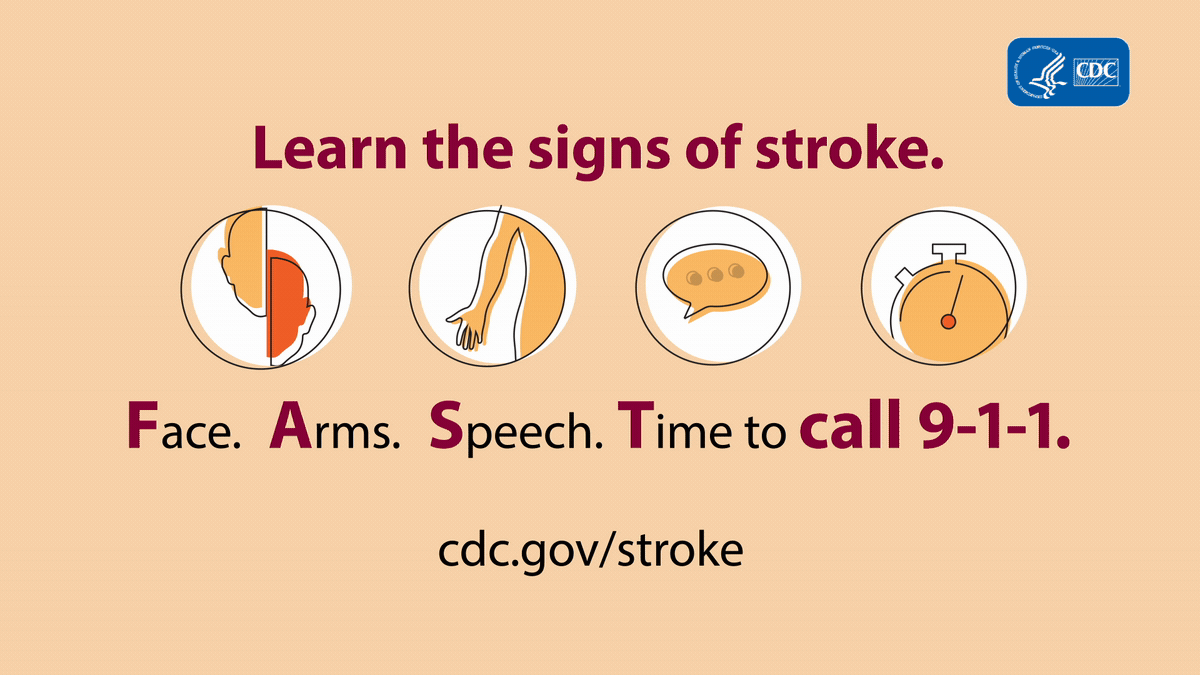 Figure 11.5.1011.5.10: Remember FAST and what it stands for if you suspect someone may have had a stroke. (Public Domain via CDC).
Figure 11.5.1011.5.10: Remember FAST and what it stands for if you suspect someone may have had a stroke. (Public Domain via CDC).
What Is the Peripheral Nervous System?
The peripheral nervous system (PNS) consists of all the nervous tissue that lies outside of the central nervous system (CNS). The main function of the PNS is to connect the CNS to the rest of the organism. It serves as a communication relay, going back and forth between the CNS and muscles, organs, and glands throughout the body.
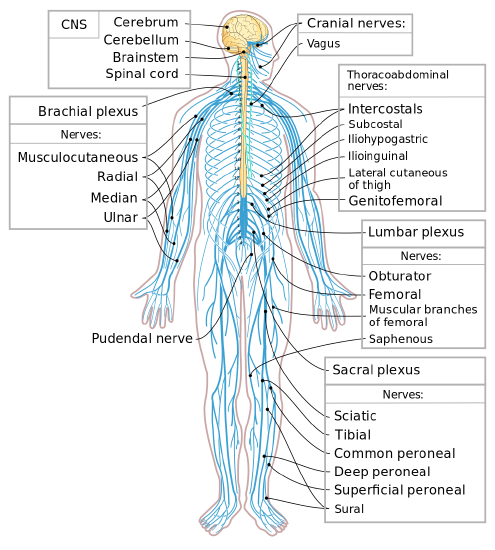
Figure 11.6.211.6.2: The nerves of the peripheral nervous system are shown in blue in this figure. (CC BY-SA 4.0 via lumenlearning.com)
Tissues of the Peripheral Nervous System
The tissues that make up the PNS are nerves and ganglia. Ganglia are nervous tissues that act as relay points for messages transmitted through nerves of the PNS. Nerves are cable-like bundles of axons that make up the majority of PNS tissues. Nerves are generally classified on the basis of the direction in which they carry nerve impulses as sensory, motor, or mixed nerves.
- Sensory nerves transmit information from sensory receptors in the body to the CNS. Sensory nerves are also called afferent nerves. You can see an example in the figure below.
- Motor nerves transmit information from the CNS to muscles, organs, and glands. Motor nerves are also called efferent nerves. You can see one in the figure below.
- Mixed nerves contain both sensory and motor neurons, so they can transmit information in both directions. They have both afferent and efferent functions.
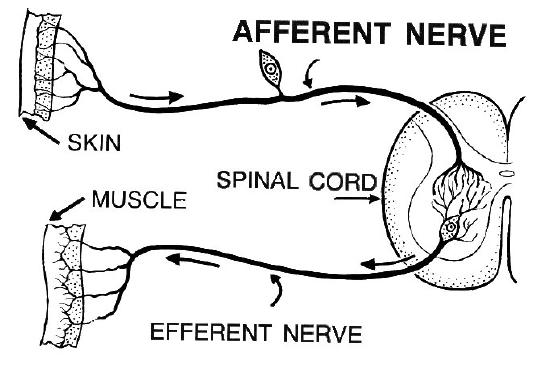
Divisions of the Peripheral Nervous System
The PNS is divided into two major systems, called the autonomic nervous system and the somatic (or sensory-somatic) nervous system. Both systems of the PNS interact with the CNS and include sensory and motor neurons, but they use different circuits of nerves and ganglia.
Somatic Nervous System
The somatic nervous system primarily senses the external environment and controls voluntary activities in which decisions and commands come from the cerebral cortex of the brain. For example, when you feel too warm, decide to turn on the air conditioner, and walk across the room to the thermostat, you are using your somatic nervous system. In general, the somatic nervous system is responsible for all of your conscious perceptions of the outside world and all of the voluntary motor activities you perform in response. Whether it’s playing a piano, driving a car, or playing basketball, you can thank your somatic nervous system for making it possible.
Structurally, the somatic nervous system consists of 12 pairs of cranial nerves and 31 pairs of spinal nerves. Cranial nerves are in the head and neck and connect directly to the brain. Sensory cranial nerves sense smells, tastes, light, sounds, and body position. Motor cranial nerves control muscles of the face, tongue, eyeballs, throat, head, and shoulders. The motor nerves also control the salivary glands and swallowing. Four of the 12 cranial nerves participate in both sensory and motor functions as mixed nerves, having both sensory and motor neurons.
Spinal nerves of the somatic nervous system emanate from the spinal column between vertebrae. All of the spinal nerves are mixed nerves, containing both sensory and motor neurons. The areas of skin innervated by the 31 pairs of spinal nerves are shown in the figure below. These include sensory nerves in the skin that sense pressure, temperature, vibrations, and pain. Other sensory nerves are in the muscles, and they sense stretching and tension. Spinal nerves also include motor nerves that stimulate skeletal muscles contract, allowing for voluntary body movements.
.png?revision=1&size=bestfit&width=377&height=533)
Autonomic Nervous System
The autonomic nervous system primarily senses the internal environment and controls involuntary activities. It is responsible for monitoring conditions in the internal environment and bringing about appropriate changes in them. In general, the autonomic nervous system is responsible for all the activities that go on inside your body without your conscious awareness or voluntary participation.
Structurally, the autonomic nervous system consists of sensory and motor nerves that run between the CNS (especially the hypothalamus in the brain) and internal organs (such as the heart, lungs, and digestive organs) and glands (such as the pancreas and sweat glands). Sensory neurons in the autonomic system detect internal body conditions and send messages to the brain. Motor nerves in the autonomic system function by controlling the contractions of smooth or cardiac muscle or glandular tissue. For example, when sensory nerves of the autonomic system detect a rise in body temperature, motor nerves signal smooth muscles in blood vessels near the body surface to undergo vasodilation and the sweat glands in the skin to secrete more sweat to cool the body.
The autonomic nervous system, in turn, has three subdivisions: the sympathetic division and parasympathetic division. The two subdivisions of the autonomic system are summarized in the figure below. Both affect the same organs and glands, but they generally do so in opposite ways.

- The sympathetic division controls the fight-or-flight response. Changes occur in organs and glands throughout the body that prepare the body to fight or flee in response to a perceived danger. For example, the heart rate speeds up, air passages in the lungs become wider, more blood flows to the skeletal muscles, and the digestive system temporarily shuts down.
- The parasympathetic division returns the body to normal after the fight-or-flight response has occurred. For example, it slows down the heart rate, narrows air passages in the lungs, reduces blood flow to the skeletal muscles, and stimulates the digestive system to start working again. The parasympathetic division also maintains internal homeostasis of the body at other times.
Disorders of the Peripheral Nervous System
Unlike the CNS, which is protected by bones, meninges, and cerebrospinal fluid, the PNS has no such protections. The PNS also has no blood-brain barrier to protect it from toxins and pathogens in the blood. Therefore, the PNS is more subject to injury and disease than is the CNS. Causes of nerve injury include diabetes, infectious diseases such as shingles, and poisoning by toxins such as heavy metals. Disorders of the PNS often have symptoms such as loss of feeling, tingling, burning sensations, or muscle weakness. If a traumatic injury results in a nerve being transacted (cut all the way through), it may regenerate, but this is a very slow process and may take many months.
Two other diseases of the PNS are Guillain-Barre syndrome and Charcot-Marie-Tooth disease.
- Guillain-Barre syndrome is a rare disease in which the immune system attacks nerves of the PNS, leading to muscle weakness and even paralysis. The exact cause of Guillain-Barre syndrome is unknown, but it often occurs after a viral or bacterial infection. There is no known cure for the syndrome, but most people eventually make a full recovery. Recovery can be slow, however, lasting anywhere from several weeks to several years.
- Charcot-Marie-Tooth disease is a hereditary disorder of the nerves and one of the most common inherited neurological disorders. It affects predominantly the nerves in the feet and legs but often also in the hands and arms. The disease is characterized by loss of muscle tissue and sense of touch. It is presently incurable.
Explore more
The autonomic nervous system is considered to be involuntary because it doesn’t require conscious input. However, it is possible to exert some voluntary control over it. For example, people who practice yoga or other so-called mind-body techniques are able to reduce their heart rate and certain other autonomic functions. Slowing down these otherwise involuntary responses is a good way to relieve stress and reduce the wear-and-tear that stress can place on the body. Such techniques may also be useful for controlling post-traumatic stress disorder and chronic pain. Three types of integrative practices for these purposes include breathing exercises, body-based tension modulation exercises, and mindfulness techniques.
Breathing exercises can help control the rapid, shallow breathing that often occurs when you are anxious or under stress. Breathing exercises can be learned quickly, and they provide immediate feelings of relief. Specific breathing exercises include paced breath, diaphragmatic breathing, and Breathe2Relax, which is a computerized breathing practice program. You can access the Breathe2Relax program with this online video:
Mindfulness techniques have been shown to reduce symptoms of depression as well as those of anxiety and stress. They have also been shown to be useful for pain management and performance enhancement. Specific mindfulness programs include Mindfulness-Based Stress Reduction (MBSR) and Mindfulness Mind-Fitness Training (MMFT). You can learn more about MBSR by watching the video below.
Candela Citations
- Overview of the Nervous System from Book: Human Biology ( LibreTexts). Authored by: Contributed by Suzanne Wakim & Mandeep Grewal Professors (Cell Molecular Biology & Plant Science) at Butte College. Located at: https://bio.libretexts.org/Bookshelves/Human_Biology/Book%3A_Human_Biology_(Wakim_and_Grewal)/11%3A_Nervous_System/11.2%3A_Introduction_to_the_Nervous_System. License: CC BY-NC: Attribution-NonCommercial
